#Kamo river delta
Explore tagged Tumblr posts
Text
Independent Excursion: Media Reflection
I chose The Tatami Galaxy, written by Tomihiko Morimi, as my media representation of Japan. The anime, adapted from the novel of the same name, is centered around Kyoto University. However, many other notable locations in Kyoto are also featured. I decided to go to some of these locations.
The first location I visited was the Shimogamo Shrine. This shrine is featured at the beginning of the first episode for its hidden ramen cart nearby, Cat Ramen. Unfortunately, the existence of this ramen cart is fiction. However, I still thought it would be fun to visit the shrine. The surrounding area of the shrine was beautiful, with thick woods arching over paved walkways.


Next, I visited Demachiyanagi Station. Being close to where the protagonist lives, the station is explicitly mentioned in the anime. While there wasn't much to see there, I ate some ramen in honor of Cat Ramen. I got the lunch set for only 1,000 yen and as you can see in the photo below, it was enormous. I highly recommend Kamomachi Ramen in Kyoto if you're in town.

After finishing eating, I embarked on the Kyoto University Clock Tower. Being a vital part of the anime's plot, it was a unique experience seeing it in person. I will elaborate further in the reflection portion, but I found it an incredible experience to see a scene from a piece of media in real life.
Finally, I ended the day with the most significant location, the Kamogawa Delta, featured in one of the anime's most memorable scenes. As Master Higuchi plays his iconic song here, the night sky is lit up in awe-inspiring fashion. Seeing this location in person made me feel a new connection to it. As one of the anime's most emotional scenes, it gave the location a weird nostalgic feeling.


Reflection
The Tatami Galaxy is a coming-of-age story of a student trying to find the perfect college life. The main protagonist is unnamed, with the name "me" in English. Every time that Watashi has doubts about his college life, he is transported into a world where he is in a different "circle." Circles are social-oriented clubs in Japanese schools, similar to many American clubs. Each time he begins a different life, the Kyoto University Clock Tower begins winding.
The Kyoto University Clock Tower looked very similar to the anime. However, I couldn't help but feel there was a difference between the anime and the real-life campus. It may be due to when I went, but it seemed much quieter. Perhaps to emphasize Watashi's perceived importance of campus life, the anime uses a variety of different colors and camera shots to make it seem more active than reality. However, this might be because of the time I went or that I wasn't allowed to explore the campus.
Another main character to mention is Master Higuchi, an eighth-year senior who lives in the same dorm as Watashi, the protagonist. Higuchi is always seen wearing a yukata and claims to be a god, passing on "wisdom" to his disciple Watashi. While his claims of being a god are seemingly absurd, his personality is beloved by many. Furthermore, the author often purposefully makes it unclear whether or not his claim of being a god is true. Who else would allow Watashi to transport to parallel universes?
One of the anime's most infamous scenes is Higuchi playing a song on the Kamogawa Delta, where the Takano and Kamo Rivers meet. Traveling to this site, there was some slippage between reality and the anime depiction. Firstly, in the anime, Higuchi is the only one in the Kamogawa Delta, making it seem like a majestic place fitting of Higuchi's mysterious character. However, traveling to this site, it becomes immediately apparent that it is a heavily traveled tourist destination. I even asked someone to take my picture there in Japanese, and they turned out to be Chinese!
Higuchi's song lyrics are seemingly nonsensical on first listen, talking about a triangle, a circle, and a square. However, they perfectly represent human's desire to be perfect. Throughout the anime, Watashi is so focused on achieving the perfect campus life that he forgets about the opportunity "dangling right in front of him," repeatedly foreshadowed by the fortune teller. When he finally forgets about his perfect campus life, he notices what he must do: ask out his crush.
Higuchi's song perfectly suits Kyoto's natural beauty. The Kamogawa Delta was a place where I could be mindful of the world around me. Sitting on the same rocks as Higuchi, I was reminded that it is sometimes important to forget about the ends of our ambitions and focus on what is in front of us now.
0 notes
Photo


Fireworks at the Kamo River Delta
8 notes
·
View notes
Text
Best picnic spot in Kyoto!
Best picnic spot in Kyoto!
Best picnic spot in Kyoto! Hi I’m Nobu, I like traveling overseas and in Japan, visited 25 countries! I’m a National Government Licensed Guide Interpreter of English for 8 years. For the people who are interested in and planning trip to Japan ,I show you hidden local information which you have never seen and heard of through books and ordinary site! You will find unexpected fun through my…

View On WordPress
1 note
·
View note
Photo

--- Demachiza ---
This is the illustration lupo for about my favorite mini theater in
Kyoto. It is called Deachiza. It is near the Kamo river delta. It has two movie theater, a cafe and a book store. you can relax there. If you went to Kyoto, you should visit there.
1 note
·
View note
Photo

Kamo River Delta seen from Kamo Ohashi Bridge. Kyoto, Japan (Aug 2017)
0 notes
Photo

Kamo River (鴨川, Kamo-gawa, duck river) https://www.ice-blog.com/travel/jp/kyoto/kamo-river/ Sakura on March 20: not yet (From the Delta to Botanical Garden) The Kamo River is located in Kyoto Prefecture, Japan. The riverbanks are popular walking spots for residents and tourists. There are pathways running alongside the river on which one can walk along the river, and some stepping stones that cross the river. https://www.facebook.com/iceblog.p #sakura #sakura2021 #cherryblossom #cherryblossoms #kyoto #japan #travel #photograph (at 鴨川 / Kamo River) https://www.instagram.com/p/CMtXYsuFmMz/?igshid=1rtsrhfhrfiud
0 notes
Photo

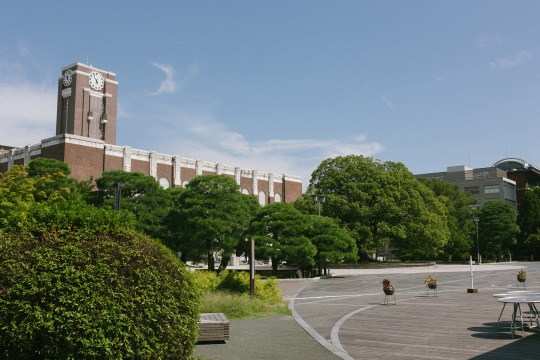


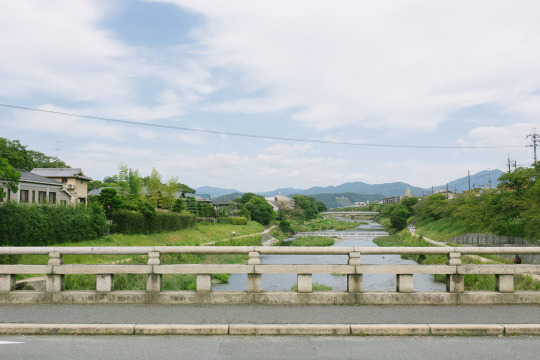

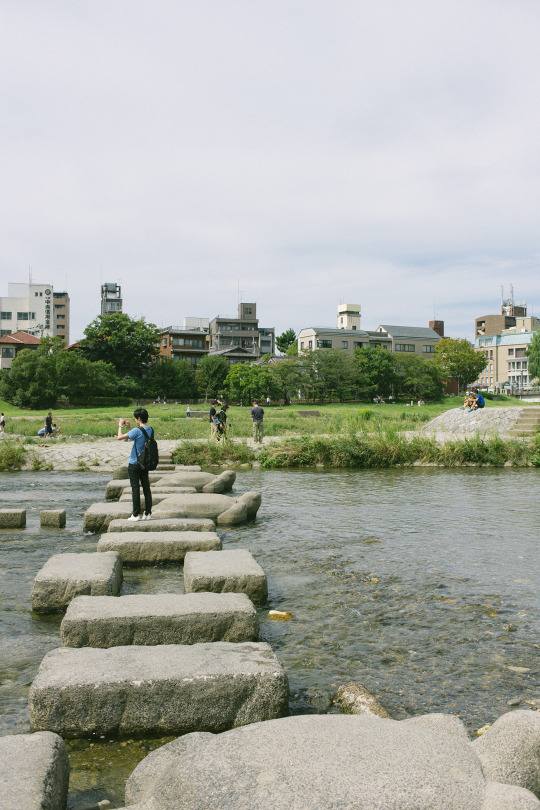
Kyoto wanderer: Kyoto University - Kamogawa river
it’s safe to say that i’ve been walking a whole lot on this trip. granted that i could’ve taken the bus, but i didn’t want to risk getting lost in translation and ending up in some rural area where i’m unable to speak nor understand anybody. and so i walked. from Ginkaku-ji, i headed west towards Kyoto University and cut across the campus grounds further west towards the Kamogawa river. i’m not a graduate of Kyodai, nor do i have any formal attachment to the institution, but as a former graduate student, i can’t help but want to visit these prestigious universities. i didn’t mention it in my Tokyo entries, but i also made a stop at Tokyo University (to eat strawberries there, for some reason), and i figured that making a stop at Kyodai should very well be part of my itinerary as well. that’s my connection to academia there to you.
finally, after more walking, i made my way to the Kamogawa delta where the Kamo and Takano rivers meet. yet another picturesque spot in Kyoto, visited mostly by locals. the delta is located further north along the river from Pontocho, making this spot somewhat off the beaten path for foreign tourists. i reckon on a clear sunny day, this spot is perfect for a picnic or a quick doze. it never fails to amaze me that there are many quaint spots like these around Kyoto that are away from the bustle of tourists and the general crowd.
#Canon EOS 6D#photography#photographers on tumblr#Kyoto University#Kyodai#Kamagawa river#Kyoto#Japan#travelogue#street#city
0 notes
Photo

0 notes
Text
Check out New Post published on Ọmọ Oòduà
New Post has been published on http://ooduarere.com/news-from-nigeria/breaking-news/371-ethnic-groups-nigeri/
The Full List Of All The 371 Ethnic Groups In Nigeria & The States Where They Originated From
Below is a comprehensive list of all Nigerian Tribes and the States where they live… 1 Abayon Cross River 2 Abua (Odual) Rivers 3 Achipa (Achipawa) Kebbi 4 Adim Cross River 5 Adun Cross River 6 Affade Yobe 7 Afizere Plateau 8 Afo Plateau 9 Agbo Cross River 10 Akaju-Ndem (Akajuk) Cross River 11 Akweya-Yachi Benue 12 Alago (Arago) nasarawa 13 Amo Plateau 14 Anaguta Plateau 15 Anang Akwa lbom 16 Andoni Akwa lbom, Rivers 17 Angas Bauchi, Jigawa, Plateau 18 Ankwei Plateau 19 Anyima Cross River 20 Attakar (ataka) Kaduna 21 Auyoka (Auyokawa) Jigawa 22 Awori Lagos, Ogun 23 Ayu Kaduna 24 Babur Adamawa, Bomo, Taraba, Yobe 25 Bachama Adamawa 26 Bachere Cross River 27 Bada Plateau 28 Bade Yobe 29 Bahumono Cross River 30 Bakulung Taraba 31 Bali Taraba 32 Bambora (Bambarawa) Bauchi 33 Bambuko Taraba 34 Banda (Bandawa) Taraba 35 Banka (Bankalawa) Bauchi 36 Banso (Panso) Adamawa 37 Bara (Barawa) Bauchi 38 Barke Bauchi 39 Baruba (Barba) Niger 40 Bashiri (Bashirawa) Plateau 41 Bassa Kaduna, Kogi, Niger, Plateau 42 Batta Adamawa 43 Baushi Niger 44 Baya Adamawa 45 Bekwarra Cross River 46 Bele (Buli, Belewa) Bauchi 47 Betso (Bete) Taraba 48 Bette Cross River 49 Bilei Adamawa 50 Bille Adamawa 51 Bina (Binawa) Kaduna 52 Bini Edo 53 Birom Plateau 54 Bobua Taraba 55 Boki (Nki) Cross River 56 Bkkos Plateau 57 Boko (Bussawa, Bargawa) Niger 58 Bole (Bolewa) Bauchi, Yobe 59 Botlere Adamawa 60 Boma (Bomawa, Burmano) Bauchi 61 Bomboro Bauchi 62 Buduma Borno, Niger 63 Buji Plateau 64 Buli Bauchi 65 Bunu Kogi 66 Bura Adamawa 67 Burak Bauchi 68 Burma (Burmawa) Plateau 69 Buru Yobe 70 Buta (Butawa) Bauchi 71 Bwall Plateau 72 Bwatiye Adamawa 73 Bwazza Adamawa 74 Challa Plateau 75 Chama (Chamawa Fitilai) Bauchi 76 Chamba Taraba 77 Chamo Bauchi 78 Chibok (Chibbak) Yobe 79 Chinine Borno 80 Chip Plateau 81 Chokobo Plateau 82 Chukkol Taraba 83 Daba Adamawa 84 Dadiya Bauchi 85 Daka Adamawa 86 Dakarkari Niger, Kebbi 87 Danda (Dandawa) Kebbi 88 Dangsa Taraba 89 Daza (Dere, Derewa) Bauchi 90 Degema Rivers 91 Deno (Denawa) Bauchi 92 Dghwede Bomo 93 Diba Taraba 94 Doemak (Dumuk) Plateau 95 Ouguri Bauchi 96 Duka (Dukawa) Kebbi 97 Duma (Dumawa) Bauchi 98 Ebana (Ebani) Rivers 99 Ebirra (lgbirra) Edo, Kogi,FCT,NasarawaBorno,Ondo 100 Ebu Edo, Kogi 101 Efik Cross River 102 Egbema Rivers 103 Egede (lgedde) Benue 104 Eggon Plateau 105 Egun (Gu) Lagos,Ogun 106 Ejagham Cross River 107 Ekajuk Cross River 108 Eket Akwa Ibom 109 Ekoi Cross River 110 Engenni (Ngene) Rivers 111 Epie Rivers 112 Esan (Ishan) Edo 113 Etche Rivers 114 Etolu (Etilo) Benue 115 Etsako Edo 116 Etung Cross River 117 Etuno Edo 118 Falli Adamawa 119 Fulani (Pulbe) Bauchi, Borno, Jigawa , Kaduna, Kano, Katsina, Kebbi , Niger, Sokoto, Taraba, Yobe, etc. 120 Fyam (Fyem) Plateau 121 Fyer(Fer) Plateau 122 Ga’anda Adamawa 123 Gade Niger 124 Galambi Bauchi 125 Gamergu-Mulgwa Bomo 126 Qanawuri Plateau 127 Gavako Borno 128 Gbedde Kogi 129 Gengle Taraba 130 Geji Bauchi 131 Gera (Gere, Gerawa) Bauchi 132 Geruma (Gerumawa) Plateau 133 Geruma (Gerumawa) Bauchi 134 Gingwak Bauchi 135 Gira Adamawa 136 Gizigz Adamawa 137 Goernai Plateau 138 Gokana (Kana) Rivers 139 Gombi Adamawa 140 Gornun (Gmun) Taraba 141 Gonia Taraba 142 Gubi (Gubawa) Bauchi 143 Gude Adamawa 144 Gudu Adamawa 145 Gure Kaduna 146 Gurmana Niger 147 Gururntum Bauchi 148 Gusu Plateau 149 Gwa (Gurawa) Adamawa 150 Gwamba Adamawa 151 Gwandara Kaduna, Niger, Plateau 152 Gwari (Gbari) Kaduna, Niger, Plateau 153 Gwom Taraba 154 Gwoza (Waha) Bomo 155 Gyem Bauchi 156 Hausa: Bauchi, Borno, Jigawa, Kaduna,Kano, Kastina, Kebbi, Niger,Taraba, Sokoto, etc 157 Higi (Hig) Borno, Adamawa 158 Holma Adamawa 159 Hona Adamawa 160 Ibeno Akwa lbom 161 Ibibio Akwa lbom 162 Ichen Adamawa 163 Idoma Benue, Taraba 164 Igalla Kogi Igbo-culture 165 lgbo: Abia, Anambra, Benue, Delta, Ebonyi,Enugu, Imo, Rivers 166 ljumu Kogi 167 Ikorn Cross River 168 Irigwe Plateau 169 Isoko Delta 170 lsekiri (Itsekiri) Delta 171 lyala (lyalla) Cross River 172 lzondjo) Bayelsa, Delta, Ondo, Rivers 173 Jaba Kaduna 174 Jahuna (Jahunawa) Taraba 175 Jaku Bauchi 176 Jara (Jaar Jarawa Jarawa-Dutse) Bauchi 177 Jere (Jare, Jera, Jera, Jerawa) Bauchi, Plateau 178 Jero Taraba 179 Jibu Adamawa 180 Jidda-Abu Plateau 181 Jimbin (Jimbinawa) Bauchi 182 Jirai Adamawa 183 Jonjo (Jenjo) Taraba 184 Jukun Bauchi, Benue,Taraba, Plateau 185 Kaba(Kabawa) Taraba 186 Kadara Taraba 187 Kafanchan Kaduna 188 Kagoro Kaduna 189 Kaje (Kache) Kaduna 190 Kajuru (Kajurawa) Kaduna 191 Kaka Adamawa 192 Kamaku (Karnukawa) Kaduna, Kebbi, Niger 193 Kambari Kebbi, Niger 194 Kambu Adamawa 195 Kamo Bauchi 196 Kanakuru (Dera) Adamawa, Borno 197 Kanembu Bomo 198 Kanikon Kaduna 199 Kantana Plateau 200 Kanufi Kaduna, Adamawa, Bomo, Kano,Niger, Jigawa, Plateau, Taraba, Yobe 201 Karekare (Karaikarai) Bauchi, Yobe 202 Karimjo Taraba 203 Kariya Bauchi 204 Katab (Kataf) Kaduna 205 Kenern (Koenoem) Plateau 206 Kenton Taraba 207 Kiballo (Kiwollo) Kaduna 208 Kilba Adamawa 209 Kirfi (Kirfawa) Bauchi 210 Koma Taraba 211 Kona Taraba 212 Koro (Kwaro) Kaduna, Niger 213 Kubi (Kubawa) Bauchi 214 Kudachano (Kudawa) Bauchi 215 Kugama Taraba 216 Kulere (Kaler) Plateau 217 Kunini Taraba 218 Kurama Jigawa, Kaduna, Niger, Plateau
219 Kurdul Adamawa 220 Kushi Bauchi 221 Kuteb Taraba 222 Kutin Taraba 223 Kwalla Plateau 224 Kwami (Kwom) Bauchi 225 Kwanchi Taraba 226 Kwanka (Kwankwa) Bauchi, Plateau 227 Kwaro Plateau 228 Kwato Plateau 229 Kyenga (Kengawa) Sokoto 230 Laaru (Larawa) Niger 231 Lakka Adamawa 232 Lala Adamawa 233 Lama Taraba 234 Lamja Taraba 235 Lau Taraba 236 Ubbo Adamawa 237 Limono Bauchi, Plateau 238 Lopa (Lupa, Lopawa) Niger 239 Longuda (Lunguda) Adamawa, Bauchi 240 Mabo Plateau 241 Mada Kaduna, Plateau 242 Mama Plateau 243 Mambilla Adamawa 244 Manchok Kaduna 245 Mandara (Wandala) Bomo 246 Manga (Mangawa) Yobe 247 Margi (Marghi) Adamawa, Bomo 248 Matakarn Adamawa 249 Mbembe Cross River, Enugu 250 Mbol Adamawa 251 Mbube Cross River 252 Mbula Adamawa 253 Mbum Taraba 254 Memyang (Meryan) Plateau 255 Miango Plateau 256 Miligili (Migili) Plateau 257 Miya (Miyawa) Bauchi 258 Mobber Bomo 259 Montol Plateau 260 Moruwa (Moro’a, Morwa) Kaduna 261 Muchaila Adamawa 262 Mumuye Taraba 263 Mundang Adamawa 264 Munga (Mupang) Plateau 265 Mushere Plateau 266 Mwahavul (Mwaghavul) Plateau 267 Ndoro Taraba 268 Ngamo Bauchi, Yobe 269 Ngizim Yobe 270 Ngweshe (Ndhang.Ngoshe-Ndhang) Adamawa, Borno 271 Ningi (Ningawa) Bauchi 272 Ninzam (Ninzo) Kaduna, Plateau 273 Njayi Adamawa 274 Nkim Cross River 275 Nkum Cross River 276 Nokere (Nakere) Plateau 277 Nunku Kaduna, Plateau 278 Nupe Niger 279 Nyandang Taraba 280 Ododop Cross River 281 Ogori Kwara 282 Okobo (Okkobor) Akwa lbom 283 Okpamheri Edo 284 Olulumo Cross River 285 Oron Akwa lbom 286 Owan Edo 287 Owe Kwara 288 Oworo Kwara 289 Pa’a (Pa’awa Afawa) Bauchi 290 Pai Plateau 291 Panyam Taraba 292 Pero Bauchi 293 Pire Adamawa 294 Pkanzom Taraba 295 Poll TarabaPolchi Habe Bauchi 297 Pongo (Pongu) Niger 298 Potopo Taraba 299 Pyapun (Piapung) Plateau
300 Qua Cross River 301 Rebina (Rebinawa) Bauchi 302 Reshe Kebbi, Niger 303 Rindire (Rendre) Plateau 304 Rishuwa Kaduna 305 Ron Piateau 306 Rubu Niger 307 Rukuba Plateau 308 Rumada Kaduna 309 Rumaya Kaduna 310 Sakbe Taraba 311 Sanga Bauchi 312 Sate Taraba 313 Saya (Sayawa Za’ar) Bauchi 314 Segidi (Sigidawa) Bauchi 315 Shanga (Shangawa) Sokoto 316 Shangawa (Shangau) Plateau 317 Shan-Shan Plateau 318 Shira (Shirawa) Kano 319 Shomo Taraba 320 Shuwa Adamawa, Borno 321 Sikdi Plateau 322 Siri (Sirawa) Bauchi 323 Srubu (Surubu) Kaduna 324 Sukur Adamawa 325 Sura Plateau 326 Tangale Bauchi 327 Tarok Plateau, Taraba 328 Teme Adamawa 329 Tera (Terawa) Bauchi, Bomo 330 Teshena (Teshenawa) Kano 331 Tigon Adamawa 332 Tikar Taraba 333 Tiv Benue, Plateau, Taraba and Nasarawa 334 Tula Bauchi 335 Tur Adamawa 336 Ufia Benue 337 Ukelle Cross River 338 Ukwani (Kwale) Delta 339 Uncinda Kaduna, Kebbi, Niger, Sokoto 340 Uneme (Ineme) Edo 341 Ura (Ula) Niger 342 Urhobo Delta 343 Utonkong Benue 344 Uyanga Cross River 345 Vemgo Adamawa 346 Verre Adamawa 347 Vommi Taraba 348 Wagga Adamawa 349 Waja Bauchi 350 Waka Taraba 351 Warja (Warja) Jigawa 352 Warji Bauchi 353 Wula Adamawa 354 Wurbo Adamawa 355 Wurkun Taraba 356 Yache Cross River 357 Yagba Kwara 358 Yakurr (Yako) Cross River 359 Yalla Benue 360 Yandang Taraba 361 Yergan (Yergum) Plateau 362 Yoruba Kwara, Lagos, Ogun, Ondo, Oyo, Osun, Ekiti, Kogi 363 Yott Taraba 364 Yumu Niger 365 Yungur Adamawa 366 Yuom Plateau 367 Zabara Niger 368 Zaranda Bauchi 369 Zarma (Zarmawa) Kebbi 370 Zayam (Zeam) Bauchi 371 Zul (Zulawa) Bauchi
If you did not see your Tribe Name in this list, you can add please.
0 notes
Photo

Japan の Day02. I watched a lot of anime, Japanese dramas. A lot of scenes are shot at Kamo river. That made me always want to be here. Finally I am here with stepped on the Kamo river with my foots and touch the water with my hands!! I felt it!! デルタ Kamogawa delta. Finally I been here!! #japan #kyoto #通り #ストリートビート #寫真を撮る #寫真 #thetravelbunch #cdxm #x100t #fujifilm #japanphotography #京都 #日本 #throwback #随拍 #streetshot #japansnapshot #snapshots #四条通 #nippon #kamoriver #鴨川 #鴨川デルタ (at 鴨川デルタ)
#京都#japansnapshot#thetravelbunch#streetshot#cdxm#ストリートビート#nippon#四条通#随拍#kyoto#x100t#寫真#fujifilm#鴨川デルタ#日本#鴨川#通り#japanphotography#kamoriver#japan#snapshots#throwback#寫真を撮る
0 notes
Text
May 21 - Free Day
Today was our first free day in Kyoto. My excursion today centered around an anime called "The Tatami Galaxy." Written by Tomihiko Morimi, the anime follows a young college student named "Watashi" or "Me" in English. The writer never gives him a name, as most of the story is narrated from his internal dialogue. I will elaborate in my media reflection, but this anime was one of my favorites due to its uniqueness.
The first site that I visited was the Shimogamo Shrine. In the anime's first episode, Watashi makes a pilgrimage to this shrine, not to pray, but to get ramen from his favorite ramen stand behind the shrine, Neko Ramen. However, unlike the anime, I decided to visit the shrine. The surrounding area of the shrine was beautiful and densely wooded with nicely paved walkways. Upon arriving, I purchased a goshuin (red seal stamp) and prayed. I would try to explain the beauty more, but a picture speaks a thousand words.
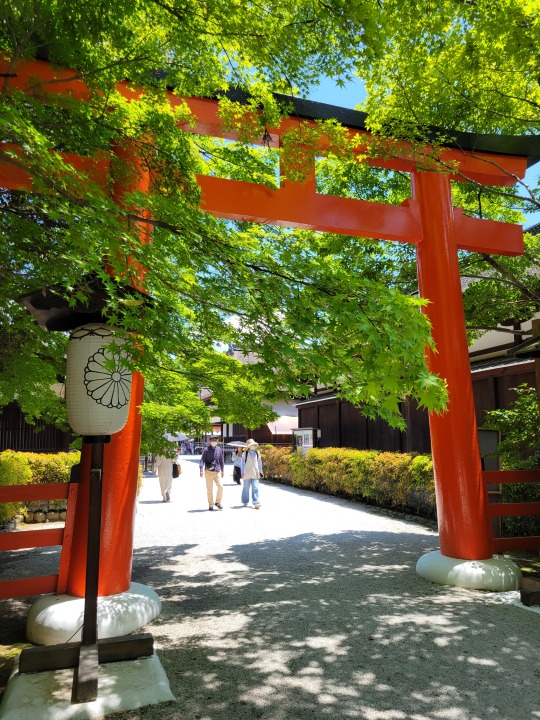
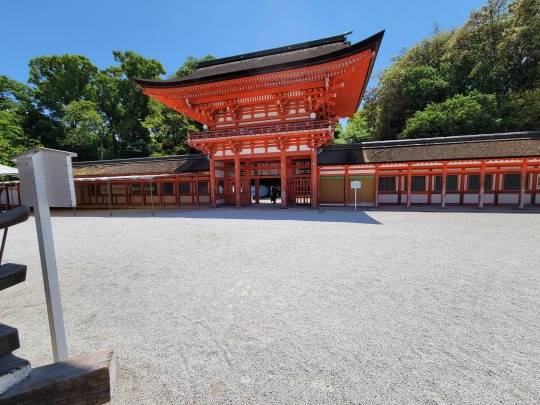
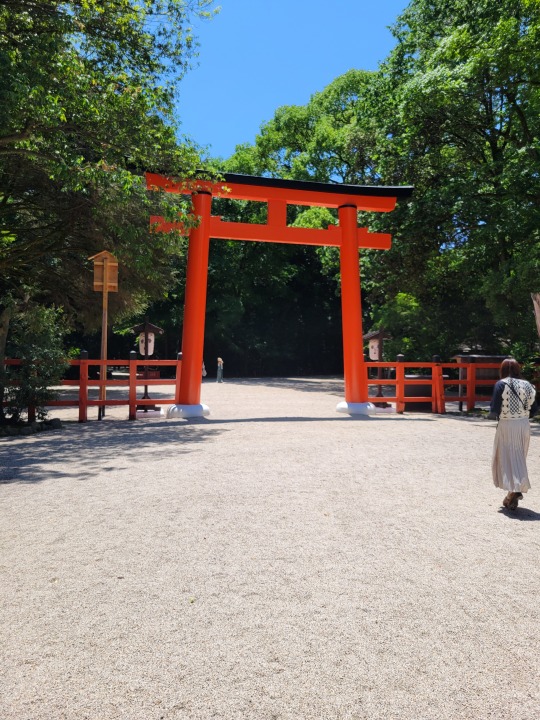
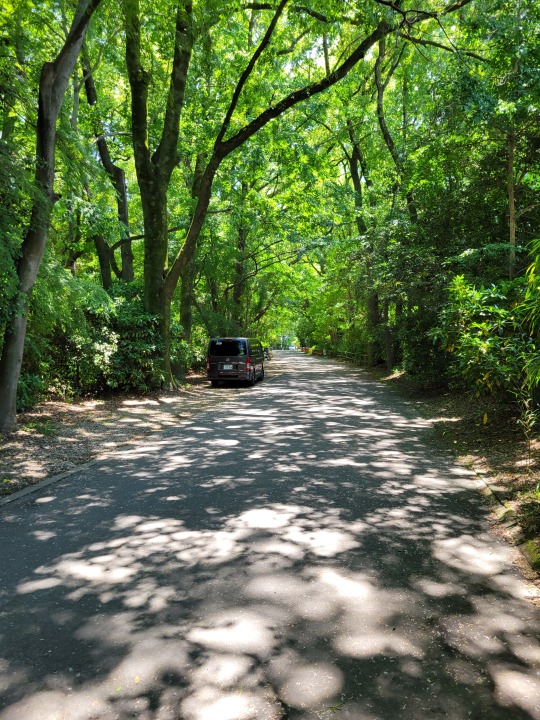
After the shrine, I visited Demachiyanagi Station. This station itself doesn't have much significance. However, I thought it would be interesting since Watashi's 4 and 1/2 tatami flat is behind this station. It was also on the way to other sites I wanted to visit, so it was worth it.
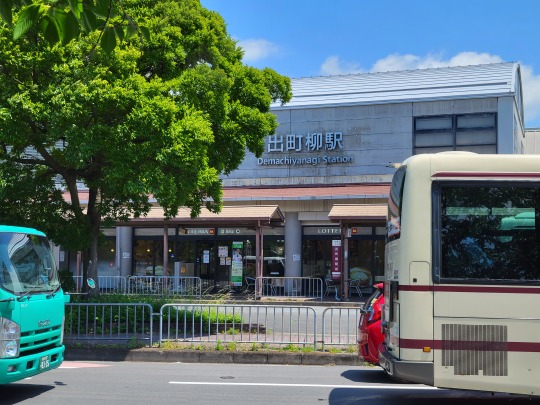
After visiting Demachiyanagi Station, I decided to have ramen nearby to reference Neko Ramen. However, Neko Ramen doesn't exist. In its place, I went to a local ramen shop called Kamomachi Ramen. This ramen shop was tiny, consisting of only a single bar. While English menus were probably available, I could read the Japanese one fine, which gave me some confidence. I ordered the daily lunch set consisting of ramen, rice, karaage shumai, and what was kind of like a spring roll. Despite being such a large portion, it was only 1000 yen! I ate it all and left the restaurant stuffed.
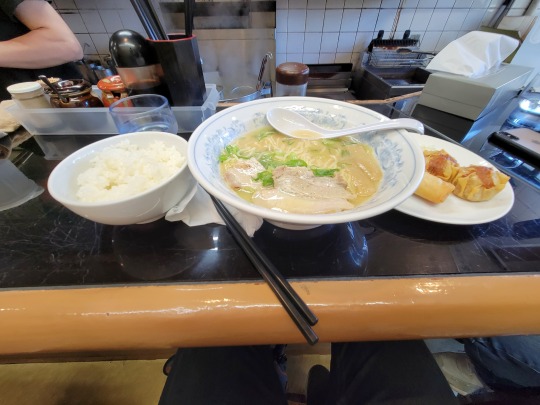
With my stomach full, I set out to the Clock Tower on the Kyoto University Campus, a crucial part of The Tatami Galaxy's story. It was interesting to see in person, but I didn't take a picture since it felt awkward with the campus guards being right in front of me. Afterward, I took a break from my anime pilgrimage and went to the arcade, UNIQLO, Yodobashi Camera, and ED ON. I played my favorite arcade game and bought a nice shirt.
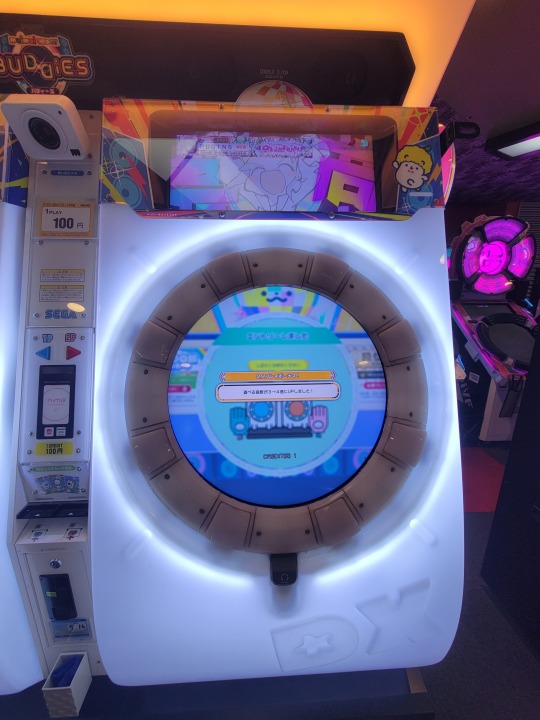

Finally, the time had come for the best part of my excursion. Once again, I will talk about it more in the media reflection, but I visited the Kamogawa Delta. This location is where the Kamo River and the Takano River meet, forming a beautiful triangle. I have attached a picture of the map below if you are still confused. The spot is in an infamous scene of the show, and having been there once before, I recognized it while rewatching it a bit. I went there during the sunset and took some breathtaking pictures. If you are old enough to drink, it would be a great spot to have one while watching the sunset with someone.
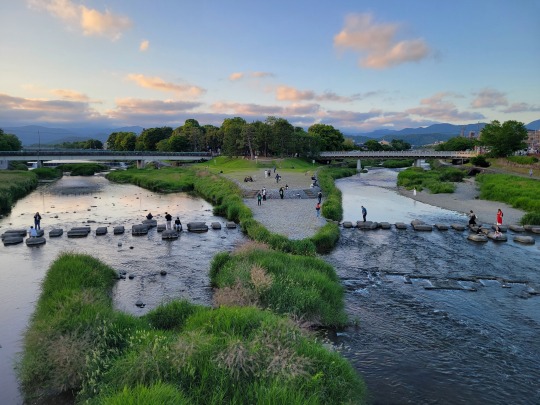
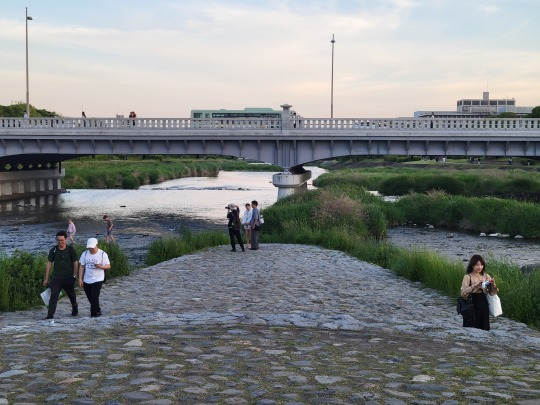
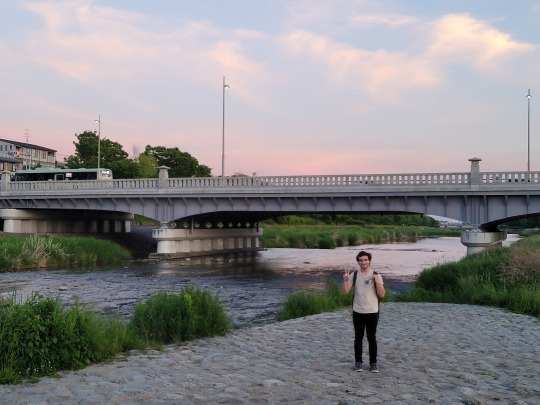
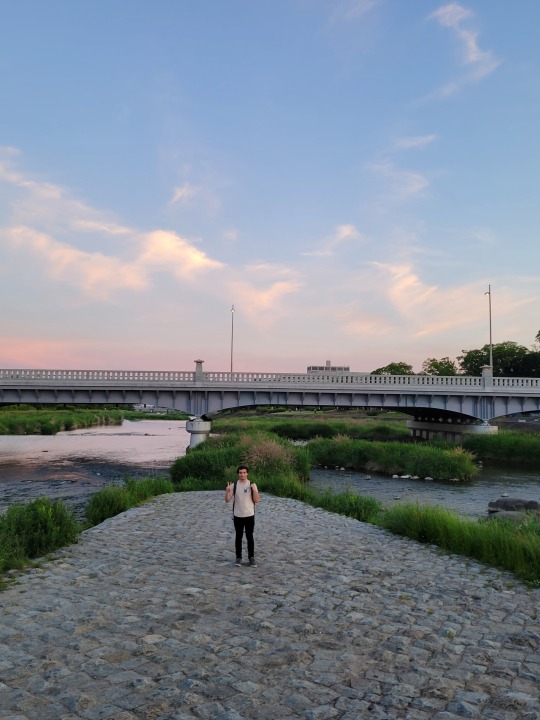
0 notes
Photo




Maybe the most exciting part of my trip to Kyoto was the incredible surprise of coming across a Japanese giant salamander.
While jumping across the stepping stones near the Kamo River Delta I noticed a strange shape under one of the stones. My friends didn’t believe me when I claimed there was a giant salamander hiding under the rock, but as I was getting my camera out it clambered out from under the rock and began to head upstream.
These amazing creatures are very rare and usually difficult to find. Seeing this one in the city is incredibly unusual.
219 notes
·
View notes
Text
The Truly Magical Real-World Locations of “The Eccentric Family 2” [Part 3]
Great news! The first season of The Eccentric Family has been re-added to the Crunchyroll library this week, so to everyone who’s been holding off on watching this season's sequel, please give this fantastic show a try! This happy occasion also marks the perfect opportunity for me to take another look atThe Eccentric Family 2’s real-world locations.
The Eccentric Family and its equally wonderful setting, Kyoto, have been basically inseparable so far, with all of the first season and the first half of the second one taking place almost exclusively in the old capital. After all, The Eccentric Family’s whimsical and unconventional take on Kyoto is a big part of the reason why this show is so exceptional, as the city itself feels just as alive as the mischievous little tanukis or the noble tengus that inhabit it. Thus it almost feels like a big deal that we finally got to see some locations outside of Kyoto in the last couple of episodes. But where does Yasaburo head off to?
*All images were taken with GOOGLE STREET VIEW (images I shot myself are marked ‘WD’)
Yasaburo heads to Arima Onsen to spy on the gathering of the tanuki-eating Friday Club, which is supposedly celebrating the joining of Soun Ebisugawa. Arima Onsen is not only The Eccentric Family’s first major setting outside of Kyoto; it’s also a very famous hot spring town in real life. The town is located in the north of Kobe, and is considered to be one of Japan’s oldest hot spring resorts. Arima Onsen has two different types of springs, one being kinsen ("gold spring"), where the water is colored brownish from iron and salt, and the other one being ginsen (“silver spring”), which contains radium and carbonate.
But this is Yasaburo we’re talking about here, a foolish tanuki that obviously doesn’t take its recon mission all too seriously and gets sidetracked by visiting a bath house. However, he does have a point when he states that he’s in Arima Onsen, and that it would almost be rude of him to not use the hot springs while there. Yasaburo visits Kin no Yu, the larger one of the town’s two public bath houses, located in the center of the city.
And as if that weren’t enough, he then heads to this quaint little café, where he enjoys an ice cold yuzu tea (basically a citron tea).
Aside from many modern buildings and hot spring inns, Arima Onsen’s center consists mostly of lovely narrow roads and old wooden buildings. The charming little town definitely fits The Eccentric Family’s unique aesthetic quite well.
Not even this shop’s ice cream is colder than Benten’s heart.
The Friday Club's “Leisure Home” is located in the outskirts of Arima. It’s here where Yasaburo gets thrown into hell by Soun.
(credit @mjvito)
Amusingly, most of the locations depicted as hell in The Eccentric Family are all modeled after real places in Tokyo. Yasaburo wanders through the very real Inokashira Park here. I’m obviously not going to read too much into this, but I’d definitely be a hilarious little dig at Tokyo from P.A. Works.
Benten’s hobby is apparently to wrestle with onis in hell; and she does so in the real Ryogoku Sumo Hall in Tokyo.
WD
While we’re still on the topic of The Eccentric Family locations outside of Kyoto, Yajiro finally decides to leave Kyoto behind in the latest episode and makes his way to Shikoku. His first stop brings him to Marugame. Pictured above is the Great Seto Bridge, a massive 13.1 kilometers (8.1 miles) series of double deck bridges connecting Okayama and Kagawa. It’s obviously not the right angle, but I took this photo atop Marugame Castle.
Yajiro then makes his way to Komatsushima in Tokushima Prefecture. He gets off at Minami-Komatsushima Station and…
(source: Wikipedia)
…heads to the northern Kincho Shrine, home of the Kincho tanuki.
(source: Wikipedia)
And why not also go international while we’re at it? That's the famous view of central London from Parliament Hill, where the Nidaime and Benten had an ominous encounter.
WD
In the end, The Eccentric Family wouldn’t be the same without Kyoto, so let’s top this article off with more Kyoto locations. (In case you missed it, I already wrote in great length about the show’s real life locations here and here.) The Nidaime and Benten’s “date” takes them to the romantic Kiyomizudera Temple, located in the hills east of Kyoto, but things obviously don’t go too well.
In the background is the temple’s wooden veranda that juts out from its main hall, offering great views of the city.
WD
The Otowa waterfall, which I talked about in my article on Tsukigakirei.
Demachi Bridge, located right next to the Kamo River delta.
Demachiyanagi Station, the first stop of the Eizan Electric Railway.
North entrance of the Teramachi Shopping Arcade.
Swimming pool close to the Ebisugawa power plant.
Inside of the modern Kyoto Station.
I can only advise Yasaburo to not enter the van (dubiously dubbed Nyoigatake Yakushibo Countermeasure Headquarters), which is parked outside of the 7-Eleven here.
Demachi Bridge again.
And last but not least, the urban Rokkaku-do Buddhist Temple is the venue for the appointment of Yaichiro as candidate for the post of the Trick Magister, and the Nidaime as observer of the election. As you can imagine, this is all much to the distaste of Benten.
The updated map:
What do you think of The Eccentric Family’s real-world locations? Sound off in the comments below!
---
You can follow Wilhelm on Twitter @Surwill.
0 notes
Text
FEATURE: Anime vs. Real Life – “The Eccentric Family 2”
Ever since Kyoto’s establishment, humans live in the city, the quirky tanuki crawl the earth, and the noble tengu fly the skies, maintaining a delicate balance in Japan’s former capital. At least that’s how the world works in P.A. Works’ contemporary fantasy anime – The Eccentric Family 2.
While the show’s supernatural story revolves around the co-existence of these mythical creatures and their complex underground societies, its setting is very much grounded in reality. This is true to such an extent that The Eccentric Family has even been appointed as Special Goodwill Ambassador by the city of Kyoto in recognition of the amount of awareness the show has raised for the town – including leading to a significant increase in tourism. There are currently a couple of cross-promotional collaboration events running throughout the city, blurring the line between anime and real life even further. And thanks to the much-needed sequel that started airing just last week, we’re getting another chance to dive into The Eccentric Family’s mystical version of Kyoto, which gives me the opportunity to take a look at the many real-world locations used in the show.
*All images were taken with GOOGLE STREET VIEW
The Eccentric Family 2 starts off with an adorable flashback about how Yasaburo’s parents met and where they married. As it turns out, these events occurred at the very appropriately named Tanukidani Fudoin Temple, located in the northeast of Kyoto. Surprisingly, the temple nowadays seems to be popular for its car blessing ceremonies.
There are a lot of these ceramic tanuki statues – which you’ll also find all across the country – scattered around the temple grounds, and also around the monument at the base of the temple here. Sadly, these ceramic statues just aren’t as cute as the tanukis in the anime.
The mid-way plateau leading up to the temple.
Yaichiro gets thrown off his automated rickshaw in this shot showing the famous Shijo Street, which is running along Kyoto’s largest shopping district. The eastern part of Shijo Street, located across the Kamo River towards Yasaka Shrine, is mainly lined by a lot of smaller shops selling local specialty foods and crafts.
Meanwhile, Yashiro walks over Kamo Bridge, crossing the Kamo River, which is Kyoto’s main river and runs from north to south straight through the center of the city. In the background you’ll notice the Kamogawa Delta, which is where the Kamo and the Takano River meet.
And Yasaburo is just lazing atop Mount Daimonji, enjoying the view and life itself, while at the same time posing as the kanji “dai” (大), meaning great or large. This is not a coincidence, since Yasaburo is lying amid the bonfire stakes forming the giant “大” during the yearly Daimonji Festival. Formally known as Gozan no Okuribi, Daimonji is a festival celebrated in Kyoto to mark the end of Obon season, which is the time of year when the spirits of one’s ancestors visit this world. And on the last day of the three-day Obon Festival, during the Daimonji event, the spirits get sent back to the spirit world guided by five massive bonfires, each with their own distinctive shape, that have been cut into the mountains surrounding Kyoto.
To the left are some of the burning areas that make up part of the character “大”. The horizontal stroke is 80 meters long, the second one curving from the top to the bottom left measures 160 meters, and the bottom right one 120 meters. The Daimonji Festival was already shown in the fourth episode of The Eccentric Family’s first season, where the whole family admired the festivities from their flying teahouse.
Yasaburo and Yashiro are coming up with their plan to catch a tsuchinoko (a snake-like being from Japanese folklore) outside of the Shimogamo Shrine. The shrine was also one of the first season’s main locations, due to the Shimogamo family living in the Tadasu Forest surrounding the shrine. It’s located right behind the already mentioned Kamogawa Delta, and is recognized as an UNESCO World Heritage Site.
The relatively small – at least by Kyoto standards – Rokudou-Chinnouji Temple is where Yajiro’s well is located. However, the well is only accessible to the public on certain days.
Benten informs Yasaburo about her spontaneous cruise around the world while they're strolling along the riverbank of the Kamo River. The specific spot here is also close to the Kamogawa Delta. The show’s visually striking painted photography backgrounds have always been a feast for the eyes, and I'm glad that also holds true for the second season.
The already mentioned Shijo Street. If you look closely at the second building on the right side, you’ll notice that the actual buildings look quite different compared to the ones in the anime. That’s because the buildings shown in the anime here have been demolished and replaced between 2013 and 2015, right after the first season aired. This could mean that this is just another old shot being reused by P.A.Works (which is totally fine, especially since they are putting out two fantastic shows this season), or that they are still basing some of their backgrounds on photos they took during their location scouting for the first season. After all, the show’s director, Masayuki Yoshihara, spent a whole month living in Kyoto in preparation for the first season of The Eccentric Family.
One of the many side streets of Shijo Street.
The Yasaka Clinic in the anime is actually a small restaurant called Izura in real life.
Kyoto Hotel Okura is where Master Akadama’s son, Nidaime, is staying during his visit.
Another one of the first season’s main locations was the area around Shijo Bridge, which makes sense since the many fancy rooftop restaurants seem like the perfect place to dine for the tengu. The Tohka Saikan was built in 1926 and now houses a Chinese Restaurant, which is where Iwayasan had dinner in the first episode of the second season.
Located diagonally across the Tohka Saikan is the restaurant Kikusui, where the Kurama Tengu are spending their evening.
And right of that, on top of the oldest kabuki theater in Kyoto, the Minami-za, is where the showdown between Master Akadama and his son Nidaime is going to go down next episode.
I’ll try to keep the map updated over the course of the season:
After finally getting to watch The Eccentric Family 2’s first episode, I realized just how much I was missing this show, and also came to the conclusion that there is still a lot for me to do and see in Kyoto, even though I’ve been there three times already.
Have you ever been to Kyoto yourself, and did you maybe recognize a couple of the locations shown in The Eccentric Family 2? Let us know in the comments!
---
You can follow Wilhelm on Twitter @Surwill.
0 notes